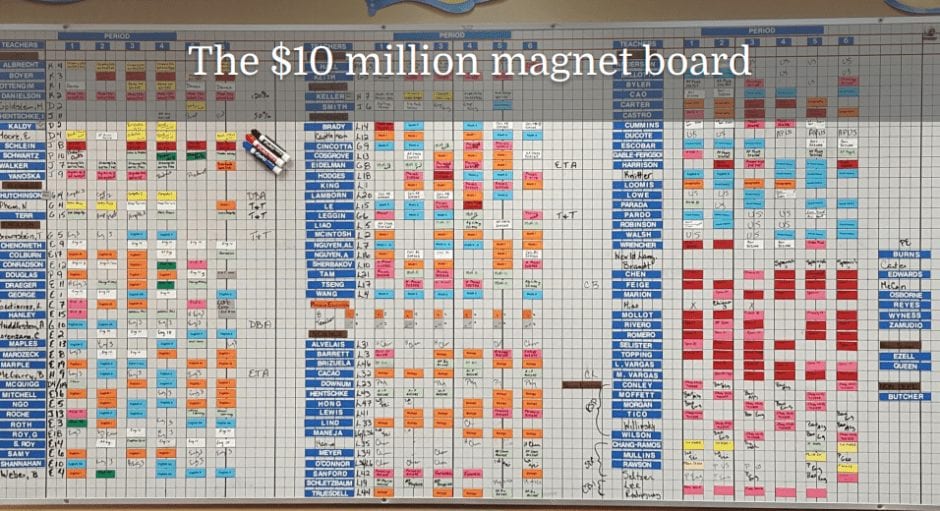Putting Students First Drives Master Schedules
In a recent edWebinar hosted by edWeb.net, Amy Filsinger, Head of School Success, Mike Rettberg, Professional Services Lead, and Chris Walsh, Head of Impact from Always Be Learning (Abl) agreed that student-centered scheduling ensures that ALL students get the classes they want and need.
The $10 Million Magnet Board
You can almost be guaranteed to see a large magnet board with its color-coded magnets in most school buildings. Filsinger stresses that “every year, there is roughly $10 million dollars being managed on a magnet board with post it notes, and expo markers.” Teachers and time periods are always represented on these magnet boards but “what is missing from this incredibly complex process is students.” Walsh underscored the point that most master schedule processes are broken. Teachers are often scheduled first with students being the last factor in master scheduling. School districts need to come up with a new way of scheduling by creating a scheduling strategy, being intentional about putting students at the center, adapting as needs change, and building team capacity to be able to tackle master scheduling in a strategic way. Rettberg advised that school districts need to “avoid turning students into numbers… We need to be looking at a process that keeps students names in the scheduling process.”
Don’t Let Your Data Fool You!
Rettberg insisted that “your SIS is probably lying to you” and not providing school districts with the most up-to-date data. Best data means best practice, so Rettberg proposes a master schedule school data audit that provides opportunities to look at different types of data that is hidden in SIS systems. Rettberg recommends that the district and building scheduling teams are trained in strategic thinking and given tools that will assist in the decision-making process by choosing data and process over intuition. Because scheduling can be a very isolating and siloed process, he advises investing in building capacity and leveraging outside experts to ensure best practices.
The Road Map
Filsinger expounds that master scheduling should not be a tactile activity delegated to school guidance counselors but a strategic activity aligned with district goals involving instructional leaders and building principals. She stresses that district leaders must make it clear that programmatic initiatives need to come alive through the master schedule. This scheduling point of view should focus on why it matters, how the master schedule can help, and the resources needed to achieve district goals. The district master schedule plan should audit and map district and school process as well as examine the quality of the data. A realistic multi-year district scheduling plan should include producing accurate scheduling data, equitability of student/teacher course loads, and increasing underrepresented student populations in advanced course. Finally, in concert with the district IT department, school districts should equip a toolbox with data norms that can accelerate a district’s ability to analyze data, standardize course codes and titles across the school and a core set of class attributes. As scheduling gets more complex, scheduling teams are getting bigger, and more programming and compliance measures are being introduced, it is critical to create a strong district scheduling plan that will highlight team roles and responsibilities, be specific about milestones, establish benchmark rubrics and most importantly put students first.
The edWeb webinar referenced above was sponsored by Abl.
This article was modified and published by EdScoop.
About the Presenters
Amy Filsinger leads the School Success Team at Abl, which provides expert scheduling guidance to secondary schools around the country. Amy is an experienced educator fascinated by school redesigns aimed at eliminating the achievement gap. Prior to joining Abl, Amy was Principal of Rocketship Brilliant Minds—a public charter school in the San Francisco Bay Area. She also served as a teacher in the Teach For America Metro-DC Corps and was a teacher leader for Rocketship Education. Amy holds a degree in foreign service from Georgetown University and is an alumna of Relay GSE’s National Principal Fellowship
Mike Rettberg is the professional services lead at Abl, where he designs and implements training programs for school and district leaders. Mike believes that education works best when teams of passionate people work together to meet the needs of all kids. Prior to joining Abl, Mike was the director of education at Education Outside, the principal of KIPP SF Bay Academy, and was an academic programs manager at Summit Public Schools. He was also a middle school science teacher in New York City and San Francisco. Mike holds a B.A. from Whitman College and an M.A. from Pace University.
Join the Community
Leadership and Innovation is a free professional learning community on edWeb.net that serves as an online forum for collaboration on leadership and innovation in schools to meet the needs of the next generation.






Comments are closed.